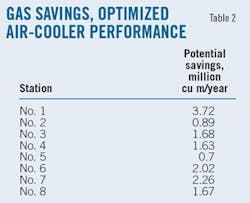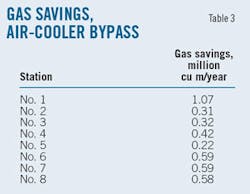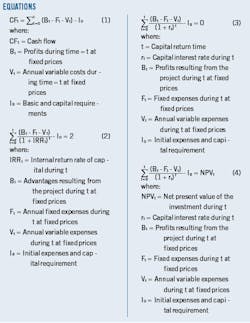Shaghayegh Khalaji
National Iranian Gas Co.
Tehran
Energy recovery and efficient scrubber technologies can help minimize energy loss on natural gas transmission systems.
Iran's natural gas pipeline system requires roughly 60% more power/unit shipped than the global average. Iranian gas does not have to travel particularly long distances, but its compressor units are of relatively low efficiency and the booster compressor stations somewhat underpowered. The system's design also occurred when domestic gas prices in Iran were very low, reducing the emphasis placed on efficiency.
The first article of this series (OGJ, Jan. 9, 2012, p. 104) outlined existing energy consumption norms in gas pipelines, describing essential parameters and criteria for comparing operational conditions with design conditions and optimum conditions. This concluding article will focus on the effect of scrubbers and other equipment in attempting to maximize capital return.
Gas turbines normally work at lower efficiency than their design condition. Reconstructing compressor stations and replacing gas turbines can increase thermal efficiency. Lost heat can be recovered to generate electricity via a Rankine power cycle. Turboexpanders can use reduction in gas pressure to generate power.
Cooling a compressor station's gas feed, meanwhile, can decrease its power requirement. Either a chiller or an air cooler can cool the gas feed. Inlet air cooling can prevent loss of output when ambient temperatures are high. Preliminary calculations, however, showed a chiller uses too much energy to be economical.
After investigation determined energy loss levels, potentials for mitigating this loss or recovering the lost energy were defined. Energy saving possibilities included reducing:
• Energy loss from scrubber pressure drop.
• Energy loss from air cooler pressure drop.
• Electrical energy consumption in air coolers.
Scrubbers
Scrubbers help separate excess liquids or undesirable particles from the gas stream as it passes through a compressor station, keeping the stream properly dehydrated.
Scrubber performance is best improved through:
• Redesign, replacement.
• Timely replacement of filters.
As mentioned in the first article of this series, scrubber pressure drop can sometimes exceed 25 psi. This scale of pressure drop requires either scrubber replacement or use of a new scrubber in parallel with the existing one. Calculations show gas savings when scrubber performance was optimized of 6.1 million cu m/year.
Table 1 shows five test stations' gas savings achieved via scrubber optimization. Savings are based on the unit's average thermal efficiency and 1,388 working hr/year (Mar. 21, 2009-Mar. 20, 2010).
Air coolers
Both redesign and replacement and a simple bypass of air coolers can reduce gas consumption. Table 2 shows the volumes of gas saved optimizing air cooler performance under average working conditions.
When ambient conditions are cool enough, the temperature of gas leaving the compressor may be low enough to enter the transfer line without first being cooled, eliminating air cooler pressure drop. Table 3 shows gas savings associated with bypassing the air cooler.
Turboexpanders can also reduce the amount of gas required to do the same quantity of work. Tables 4, 5, and 6 show the savings realized by this approach, respectively showing power use when outlet-gas temperature is the same as ambient temperature, when outlet-gas temperature is cooled as much as possible, and when inlet gas is preheated.
Economic analysis
Energy optimization requires advantages and costs to be reported and assessed in financial terms. The indices such assessments use are:
• Cash flow (Equation 1).
• Internal rate of return (Equation 2).
• Capital return time (Equation 3).
• Net present value of investment (Equation 4).
Assumptions
The external parameters used in calculating project economics include:
• Expenses and incomes set at 2010-11 levels.
• Real interest rate for net value calculation of 5%.
• Oil price in international markets of $60/bbl, yielding a natural gas price of $0.25/cu m and a power supply price of $0.09/kw-hr.
• Iranian thermal power plant efficiency of 35%.
• Rankine cycle technical data yielding a design-cycle efficiency of 17.4%
Cost analysis
Five basic energy optimization solutions emerged through flow process study at the sample compressor stations:
• Heat recovery from chimney gases and electric power production.
• Gas turbine reconstruction.
• Cooling natural gas feed.
• Cooling natural gas leaving compressor.
• Scrubber optimization.
Economic investigation exposed the characteristics of each feasible solution (Table 7).
Scrubber optimization is the best approach, significantly lowering costs and energy consumption in natural gas transfer lines. Cooling natural gas before and after compressors is justifiable in some stations, and gas turbine reconstruction and replacement is justifiable in older, less efficient units.
Cost-benefit analysis
Energy is gradually lost in gas pressure reduction stations, dissipating the mechanical work potential produced by compressors. The recovery of mechanical potential and its transformation into work and the production of electric energy is, therefore, a suitable mechanism for energy optimization in a natural gas system.
Table 9 contains expansion turbine data for both small (less than 10,000 cu m/hr normal gas flow) and large units (500,000 to 1 million cu m/hr normal gas flow).
Table 10 shows economic analyses based on $60/bbl crude oil. The internal return rate in a 4-year exploitation period will be more than 26%/year. The present value of the investment in a small system for the 4-year exploitation period will be $117,000 and in large systems $18.62 million. Mechanical recovery is economically justifiable and provides a basic solution for energy recycling in compressor stations.
Solution prioritization
As shown in Part 1, only Organic Rankine cycle for energy recovery and optimization of scrubbers are economically feasible in all instances, the rest of the solutions being viable only in particular situations.
Table 11 shows detailed economic analyses for sample stations using five different crude prices.
More Oil & Gas Journal Current Issue Articles
More Oil & Gas Journal Archives Issue Articles
View Oil and Gas Articles on PennEnergy.com













